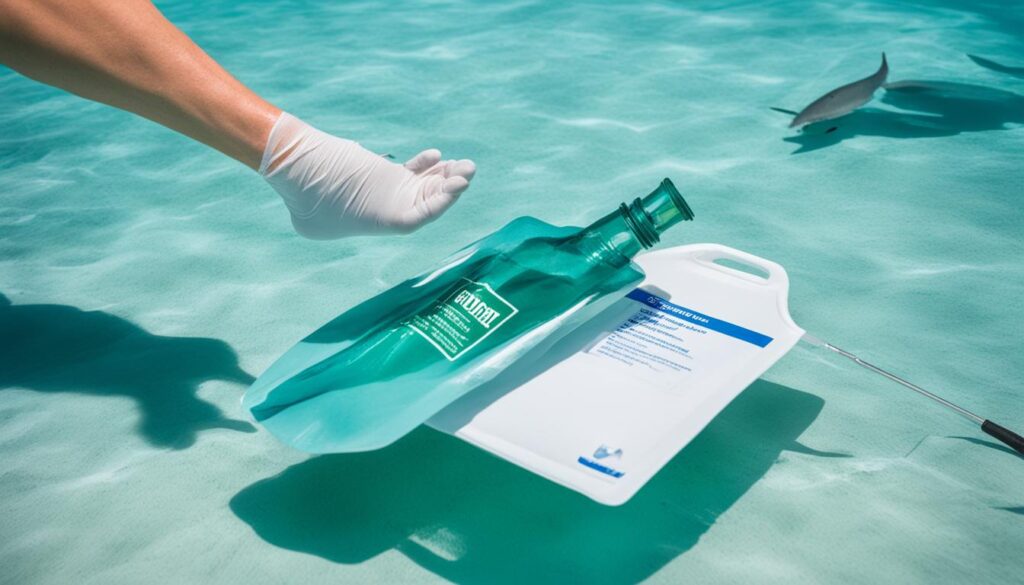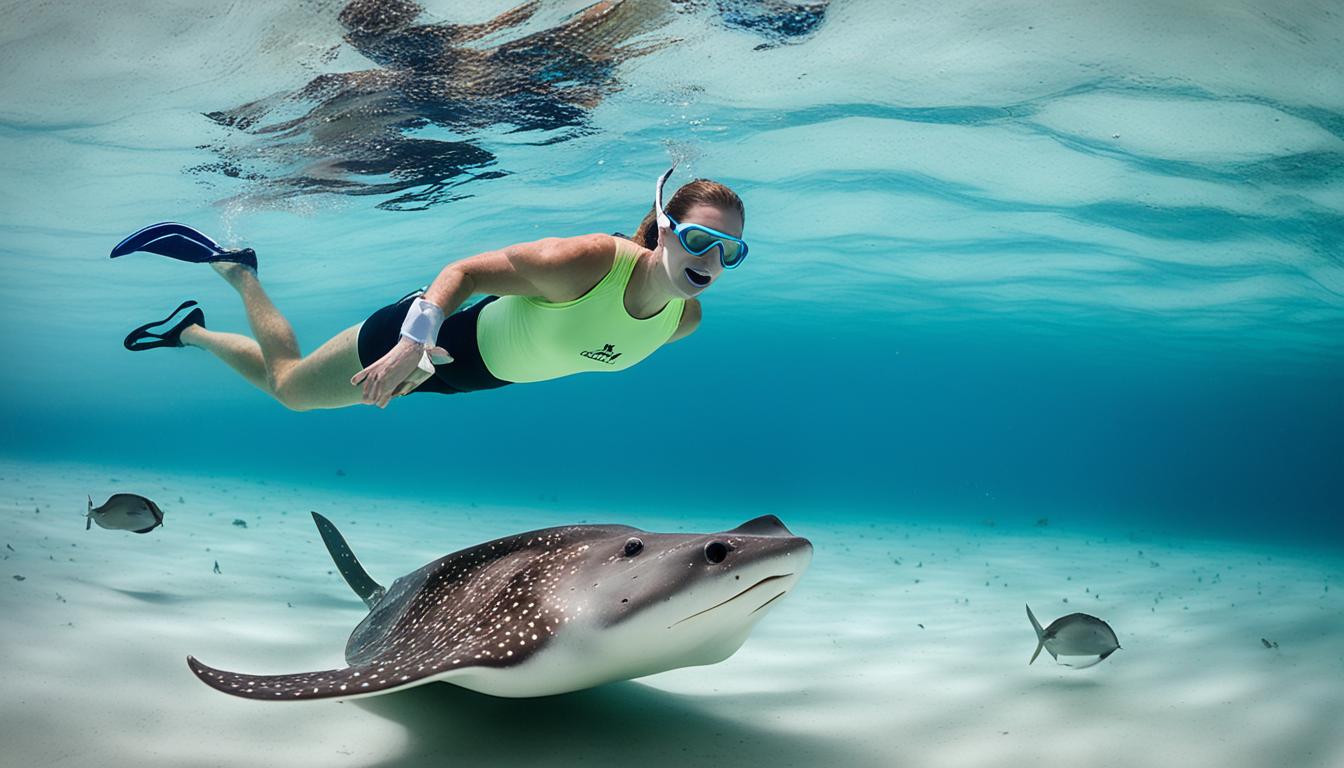Many people wonder if stingrays are dangerous to humans, especially after the sad event with Steve Irwin in 2006. This incident has made people think stingrays are more risky than they really are. But, it’s important to know the truth.
Stingray attacks that are deadly are very rare. Many people safely interact with stingrays every year. The media makes it seem like stingrays are more dangerous than they actually are.
Learning how to stay safe around stingrays can help reduce fear. By looking at the real numbers and learning about these animals, you can feel more confident when you meet stingrays.
The Stingray Stigma
The stingray stigma is the fear and negative views people have of stingrays. This comes from how the media shows them. News and movies often focus on bad encounters, making people scared. Events like Steve Irwin’s death have made people more worried about stingrays.
But, stingray injuries are actually quite rare. Still, people are more scared than informed. They often misunderstand stingrays because of these misconceptions. This makes people uneasy when they see stingrays, even though they shouldn’t be.
By teaching more about stingrays, we can change how people see them. Showing stingrays as peaceful marine animals can help fight the bad image from the media. We need to change the scary story to a story of appreciation.
Understanding Stingrays
Stingrays are fascinating creatures that live in many water environments. Learning about the different types and their looks helps us better understand these interesting rays. Some stingrays have venomous spines, but others are harmless. You can safely interact with them in certain places.
Types of Stingrays
There are many types of stingrays, each with its own special traits. Some examples include:
- Southern Stingray – Found in shallow coastal waters.
- Atlantic Stingray – Known for its rounded shape.
- Manta Ray – The biggest stingray, known for its beautiful swimming.
- Cow Nose Ray – Has flat heads and likes to be in groups.
Physical Characteristics
The looks of stingrays help them survive and behave. Key features are:
- Flat bodies – Perfect for moving on the ocean floor.
- Wide fins – Helps with swimming and staying stable.
- Eyes and mouth positioning – On top, giving them a good view while staying hidden.
Knowing these traits helps us understand how stingrays live and interact with humans.
Are Stingrays Dangerous to Humans?
It’s important for beachgoers and ocean lovers to know about stingrays. Most of the time, meeting a stingray is safe. But, it’s good to look at the facts about their dangers.
Statistics on Stingray Injuries
Every year, there are about 1,500 to 2,000 stingray injuries in the U.S. These happen when someone steps on a stingray without seeing it in shallow water. Most of these injuries are just painful cuts, not serious enough to be deadly.
| Year | Reported Injuries | Fatalities from Stingrays |
|---|---|---|
| 2018 | 1,700 | 0 |
| 2019 | 1,900 | 1 |
| 2020 | 1,600 | 0 |
| 2021 | 1,500 | 0 |
| 2022 | 2,000 | 0 |
Rare Instances of Death
Stingray attacks on humans are not common, and deaths are very rare. In fact, there have been fewer than 20 documented deaths worldwide. This shows that stingrays are not a big threat to humans.
Stingray Behavior and Interaction with Humans
It’s important to know how stingrays behave to avoid negative interactions with humans. These creatures are usually not aggressive and try to stay away from trouble. Most of the time, stingrays sting people by accident, often when people step on them in their sandy homes.
In shallow, sandy waters, you’re more likely to see a stingray. If you’re swimming or walking in these areas, you might accidentally step on one. This can make the stingray sting you as a defense. Knowing how stingrays act can help you avoid these situations. Always keep a safe distance and don’t startle them.
- Stingrays are generally shy and prefer to retreat when approached.
- Burial in sand makes them difficult to spot.
- Accidental steps can trigger defensive responses.
- Respect for stingrays fosters safer interactions.
Teaching people about stingray behavior and their homes helps everyone interact with them safely. With the right knowledge and care, stingray meetings can be amazing experiences. They let us see these creatures in their natural setting.
How to Avoid Stingray Stings
To enjoy the ocean safely, it’s key to follow some important safety tips. These tips help lower the risk of stingray stings. By using certain methods, you can greatly reduce the chance of a harmful encounter with stingrays.
Best Practices While Swimming
When swimming where stingrays live, follow these important tips:
- Always be aware of your surroundings and keep an eye out for warning signs on the beach.
- Avoid swimming in murky waters where visibility is low.
- Use a pole or stick to gently probe the sandy bottom in front of you to alert any nearby stingrays of your presence.
The Stingray Shuffle
The stingray shuffle is a way to avoid stingrays. This method means shuffling your feet on the sandy ocean floor instead of walking normally. By doing this, you make vibrations that warn stingrays you’re coming. This tells them to swim away before they could sting you.
First Aid for Stingray Stings
If you get a stingray sting, it’s key to know what to do first. The steps you take right away can really make a difference. Learning how to treat stingray injuries can ease the pain and stop infections.
Immediate Response and Treatment
When you get a stingray sting, act fast:
- Rinse the wound gently with fresh water.
- Immerse the affected area in hot water (ideally around 110°F or 43°C) for 30 to 90 minutes. This helps neutralize toxins and reduces pain.
- Clean the wound thoroughly to prevent any debris from causing an infection.
- Apply a sterile bandage to protect the area from further injury.
When to Seek Medical Attention
Know when you need a doctor’s help. Get medical help if:
- The wound goes deep.
- There’s a lot of bleeding that won’t stop.
- You see signs of infection, like more redness, swelling, or a fever.
Knowing how to help with stingray stings can calm you down in an emergency. Remember, quick action can make a big difference.

| Action | Details |
|---|---|
| Rinse the wound | Use fresh water to cleanse the injury. |
| Hot water immersion | Immerse the sting area in water at 110°F for 30-90 mins. |
| Wound cleaning | Remove debris to prevent infection. |
| Bandaging | Cover the wound with a sterile bandage. |
| Seek medical help | If deep wound, severe bleeding, or signs of infection occur. |
The Effects of Stingray Venom
It’s important to know how stingray venom affects humans, especially if you’re near these creatures. After a sting, you might feel a lot of pain, swelling, and bleeding at the injury site. These symptoms are serious and need quick action.
Symptoms of Stingray Stings
You could also feel nausea, vomiting, and muscle cramps after a sting. These symptoms come from the venom and can make you feel really bad. Watching how you feel is key to getting the right treatment fast.
Potential Complications
Most stingray injuries can be treated with basic first aid. But, there are serious issues like infections or allergic reactions to the venom. In rare cases, you might have trouble breathing. Knowing these risks helps you stay safe around stingrays.










